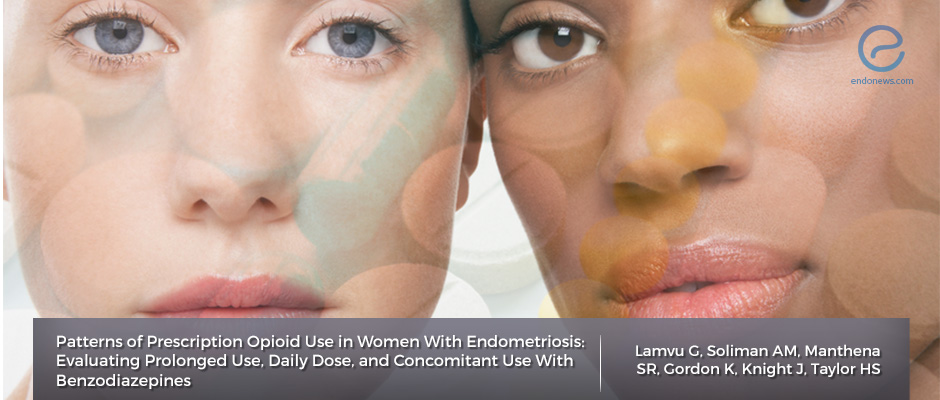Prescription Opioid Use in Women With Endometriosis
Jul 26, 2019
Women with endometriosis are more likely to use opioids, for prolonged periods, and concomitantly with benzodiazepines compared to women without this condition.
Key Points
Importance
- Little research so far has investigated patterns of opioid use in women with endometriosis.
What’s Done Here
- Data was obtained from Optum Clinformatics Data Mart, which contains information from more than 150 million individuals.
- This is a retrospective, matched cohort study. Women with endometriosis were matched to women without endometriosis.
- The index date was defined as the first date from January 2006 through December 2016 that an endometriosis diagnosis was recorded.
- Outcomes of women with endometriosis were compared to outcomes of women in the control group.
- Outcomes were reanalyzed after excluding opioid prescriptions filled in the 30 days after the first post-index period surgery date. This is because opioid prescription and use can occur post-surgery.
Key Results
- The sample consisted of 44,566 women in the case group and 89,132 women in the control group.
- Women with endometriosis, compared with women without, were more likely in the post-index period to:
- Have filled at least one prescription for an opioid;
- Have filled multiple prescriptions for opioids;
- Fill prescriptions for an opioid for a longer period;
- Have filled prescriptions for opioids and benzodiazepines concomitantly, for longer periods.
- The above patterns were similar in the re-analyses excluding opioid prescriptions filled in the 30 days after the first post-index period surgery date.
Limitations of the Study
- Results may not be generalizable as all women in the study were well-insured.
- Patients with endometriosis were identified based on diagnostic codes, which may or may not have been the product of rigorous diagnostic procedures.
- The index date for patients with endometriosis may not have reflected the actual initial diagnosis if that diagnosis was recorded before the data study period of 2005 through 2017.
- Researchers could confirm that prescriptions were filled but not how the medication was taken by individuals with endometriosis.
Lay Summary
In this study, researchers examined opioid use, opioid prescribing patterns, and timing of the first opioid prescription in endometriosis patients compared with matched women in the control group without endometriosis. A retrospective analysis of Optum Clinformatics Data Mart was conducted. This database contains data from over 150 million individuals and is used by healthcare providers for reimbursement of a service or product provided.
Women with endometriosis were matched to women without endometriosis, the control group, based on factors such as age, geographic region of residence, race, payer type, insurance plan type, and index date. The index date was defined as the first date that an endometriosis diagnosis was recorded. The outcomes of women with endometriosis were compared to outcomes of women in the control group. These outcomes included filling of a prescription for an opioid medication, filling multiple prescriptions for opioids, the total number of days’ supply of opioid medication, and the opioid’s daily dose, which was based on morphine milligram equivalents. Outcomes were reanalyzed after excluding opioid prescriptions filled in the 30 days after the first post-index period surgery date. This is because opioid prescription and use can occur post-surgery.
The sample consisted of 44,566 women in the case group and 89,132 women in the control group. Women with endometriosis, compared with women without, were more likely in the post-index period to have filled at least one prescription for an opioid (79.3% vs 24.2%; P,.001) and to have filled multiple prescriptions for opioids (40.3% vs 10.5%; P,.001). They also filled prescriptions for an opioid for a longer period: “Specifically, in the post-index period, the endometriosis cohort was more likely to have filled opioid prescriptions with total days supplied extending for 31–59 days (4.2% vs 1.1%), 60–89 days (1.5% vs 0.5%), or 90 days or more (5.5% vs 2.5%) (all P,.001; Fig. 3). Women with endometriosis were also more likely to have filled prescriptions for opioids and benzodiazepines concomitantly (10.1 vs 3.5%), for longer periods, (10.1 vs 3.5%), and such concurrent supply extended for at least 7 days (6.0% vs 2.0%), 30 days (3.0% vs 1.2%), or 90 days (1.6% vs 0.7%) (all P,.001). These patterns were similar in the re-analyses excluding opioid prescriptions filled in the 30 days after the first post-index period surgery date.
The authors note that the results of the study are “generally consistent with the results of a 2016 survey, conducted by fellows of the American College of Obstetricians and Gynecologists (ACOG), which indicated that patients with endometriosis receive nearly one quarter (24%) of the opioid mediation prescribed by U.S. obstetrician-gynecologists.” They also highlight concerns about the concomitant use of opioids and benzodiazepines, as “patients taking opioids and benzodiazepines concurrently are an estimated 10 times more likely to die an overdose death relative to those taking opioids alone.” The researchers also state that the study shows how prescribers are not abiding by current ACOG guidelines which suggest using the fewest opioid pills appropriate and avoiding the use of opioids in treating noncancer, chronic pain.
Research Source: https://www.ncbi.nlm.nih.gov/pubmed/31135725
endometriosis opioids benzodiazepines prescription opioid use

